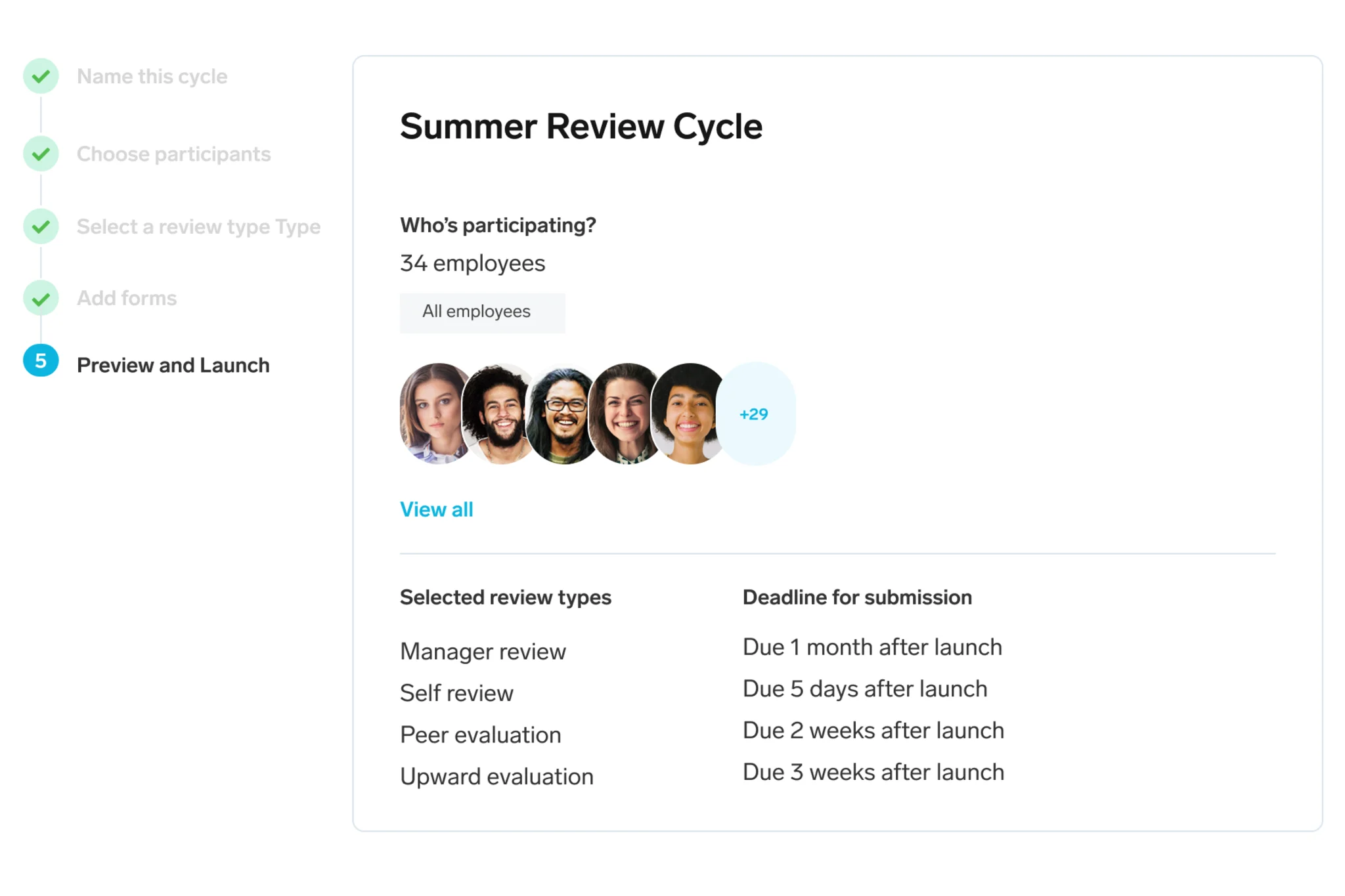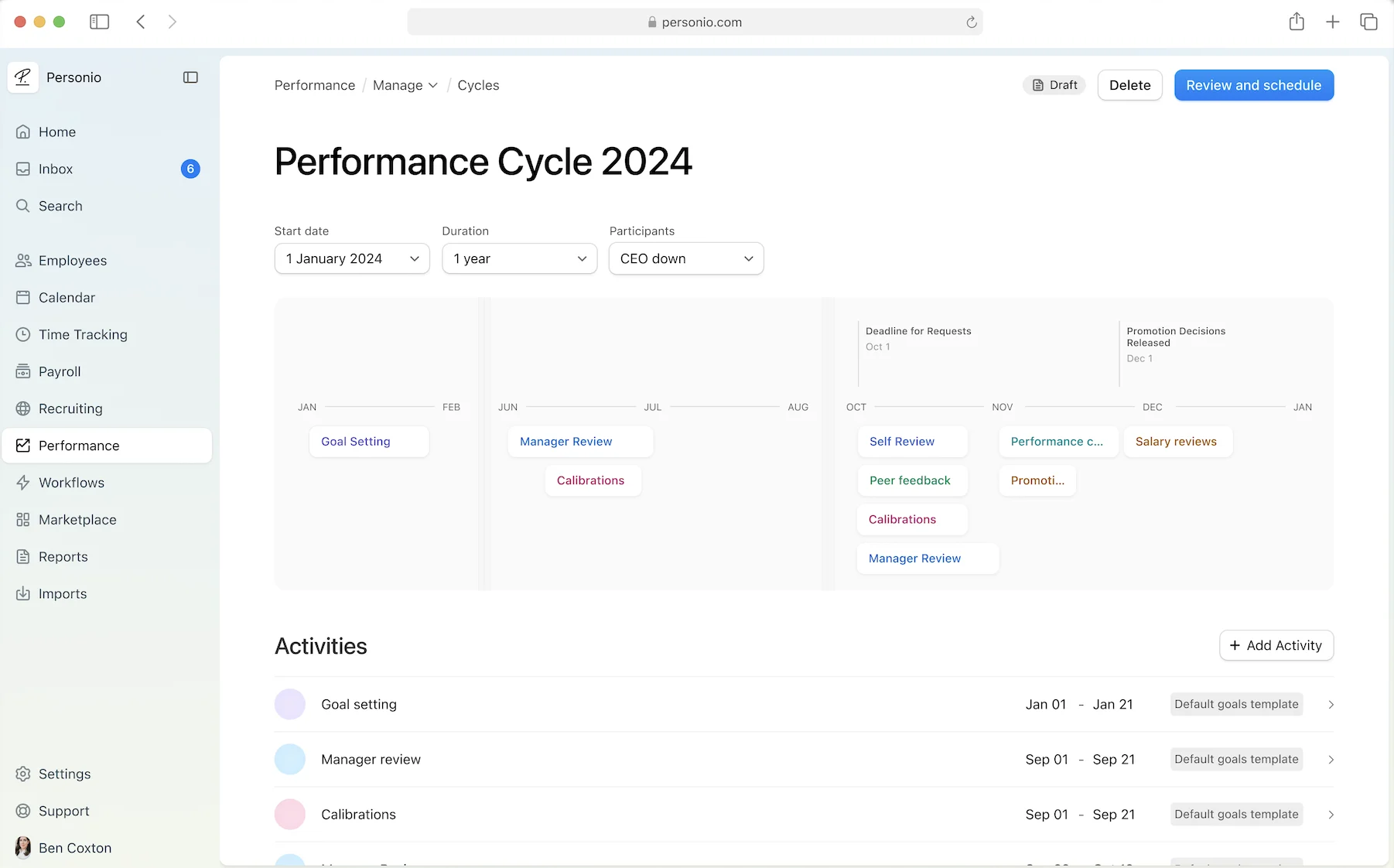
Centralise HR processes in a single platform
Create HR workflows and build better review cycles with Personio's intuitive performance management software
Find out moreBeyond Reviews: Modern Performance Appraisals for Today's Teams

How should your average organisation handle the objectives of performance appraisals? For many, it may seem simple, but it can quickly spiral out of control. What is already a stressful time for employees is now a stressful time for just about everyone.
How do you run an effective employee performance appraisal process that satisfies (and doesn't stress out) everyone? In this article, we break down some of the key insights, best practices and process steps that you can start following today.
A good appraisal rests on a good conversation. Download our review template today.Contents
What is a performance appraisal?
A performance appraisal is a structured conversation between an employee and their line manager, aimed at reviewing the employee's job performance and overall contribution to the organisation. This process is a key component of the broader performance management cycle, typically overseen by HR.
Performance appraisals serve multiple purposes:
To provide employees with feedback on their performance, highlight areas for improvement and recognise achievements.
To discuss potential changes such as promotions, pay raises, or other career advancements.
Often referred to as performance reviews, annual reviews or employee evaluations, performance appraisals are critical touchpoints in the employee lifecycle. They can be conducted annually, semiannually or quarterly, depending on your organisation's standard policies. In short, they help organisations:
Identify high-performing employees
Understand their contributions to the company's growth
Make informed decisions regarding rewards and development opportunities
However, it is essential that the appraisal process aligns with the company's culture to ensure employee satisfaction and engagement.
Types and methods of performance appraisals

By understanding the types and methods of performance appraisals that exist, HR professionals can go out and select the most appropriate approach for your organisation.
Here are some of the most common methods and who might benefit from them the most:
1. Top-down appraisal
Explained: In this traditional and very popular method, a manager reviews the performance of their direct reports in a top-down fashion.
Best for: Organisations with clear hierarchical structures where line managers have a comprehensive understanding of their team members' roles and responsibilities.
Advantages: Provides a clear and authoritative perspective on performance.
Disadvantages: May lack input from peers or the employee themselves, potentially leading to a very one-sided evaluation.
2. 360-degree feedback
Description: This method gathers feedback from various sources, including peers, subordinates, and sometimes clients, in addition to the manager’s review.
Best for: Organisations that value a holistic view of employee performance and encourage a culture of open feedback.
Advantages: Offers a well-rounded perspective, highlighting strengths and areas for improvement from multiple viewpoints.
Disadvantages: Can be time-consuming and may require training to ensure constructive feedback.
3. Self-assessment
Description: Employees evaluate their own performance, often using a structured format provided by the organisation.
Best for: Encouraging self-reflection and personal accountability among employees.
Advantages: Empowers employees to take ownership of their development and can reveal insights into their self-perception.
Disadvantages: May be biased, as employees might overrate or underrate their performance.
4. Peer review
Description: Colleagues at the same hierarchical level assess each other’s performance.
Best for: Teams with collaborative work environments where peer input is valuable.
Advantages: Provides insights from those who work closely with the employee, often highlighting teamwork and collaboration skills.
Disadvantages: Can be influenced by personal relationships and may require mechanisms to ensure objectivity.
5. Management by objectives (MBO)
Description: Employees and managers set specific, measurable goals at the beginning of a review period and assess performance based on the achievement of these goals.
Best for: Organisations focused on goal alignment and measurable outcomes.
Advantages: Clarifies expectations and aligns individual performance with organisational objectives.
Disadvantages: May overlook qualitative aspects of performance and can be rigid if goals need to be adjusted mid-cycle.
6. Behaviourally anchored rating scales (BARS)
Description: Uses specific behavioural examples to rate performance on a scale.
Best for: Roles where specific behaviours are critical to performance.
Advantages: Provides clear standards and reduces ambiguity in evaluations.
Disadvantages: Developing the scales can be complex and time-consuming.
As you can, each method for performance appraisals has its own host of benefits and drawbacks. The key is understanding which method will serve your organisation in its unique stage of growth, and review or iterate when appropriate.
Benefits of performance appraisals
Some of the top benefits of running great performance appraisals include:
Improved employee performance | Performance appraisals provide employees with feedback on their strengths and weaknesses, which can help them improve in their work. |
Increased employee engagement | When employees feel that they are recognised and that they are being given opportunities to grow, they are more likely to engage in their work. |
Reduced employee turnover | Employees who feel that they are being treated equitably and are progressively growing and developing are more likely to stay with their employer. |
Improved decision-making: | Performance appraisals can provide leaders with valuable information that they can use to make better decisions about employee training, promotion and compensation. |
Enhanced communication | Performance appraisals can provide a forum for open and honest communication between employees and managers. |
7 steps to facilitating great performance appraisals
Performance appraisals can be a helpful tool to improve employee engagement, aid staff development, and measure employee performance as part of an effective talent management strategy. This is true only when they are handled correctly.
So, we have pulled together a 7-step approach to facilitate great performance appraisals, based on our own personal experience as well as research into industry best practices…
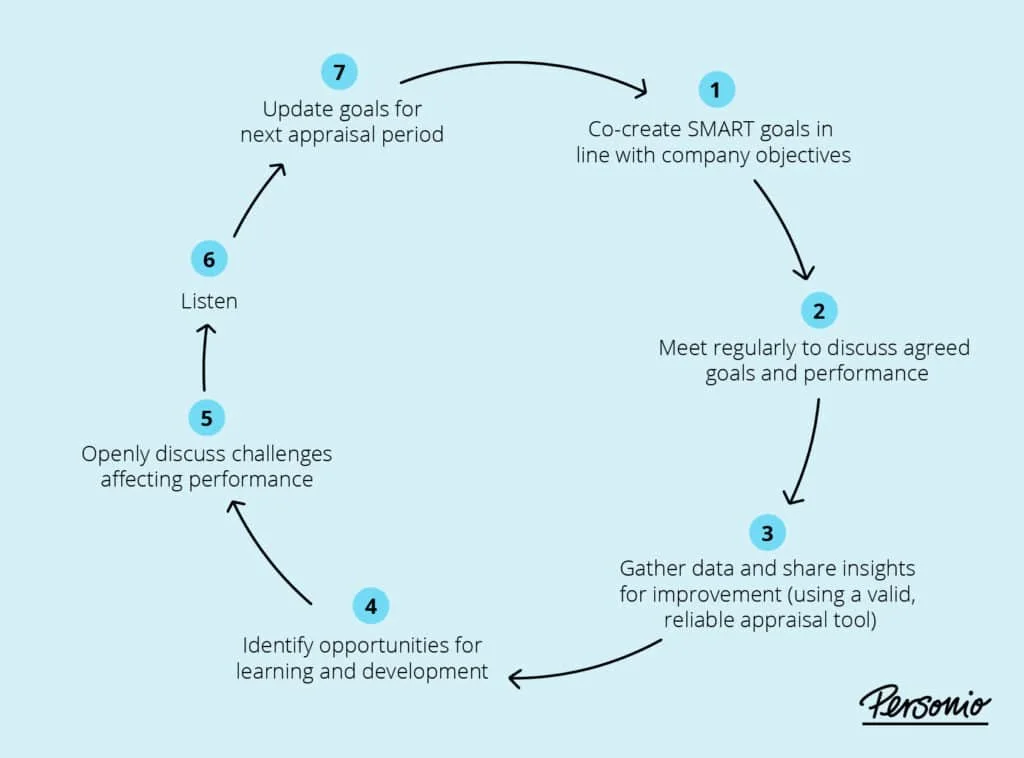
1. Co-create ‘SMART’ goals in line with company objectives
The best performance goals are aligned with the organisation’s broader objectives, the general purpose of the department that the employee works in, and are SMART (Specific, Measurable, Achievable, Relevant, and Time-bound).
When these goals are co-created between employees and managers, employees are more likely to buy into them and, therefore, more likely to attempt to achieve them.
2. Meet regularly to discuss agreed goals and performance
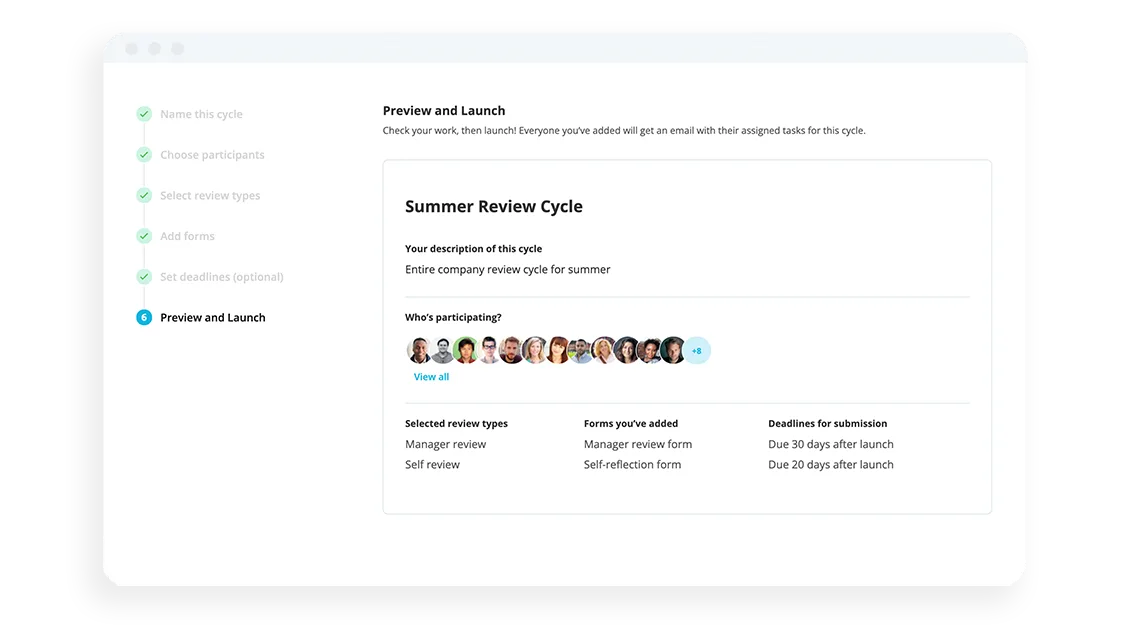
Many performance appraisals are challenging because, since they happen so infrequently, employees and managers have forgotten what happened at the beginning of the appraisal period (typically a year ago). So, they become based on our human (and fallible) memories as well as the prevailing feeling at the time.
Take the stress out of performance reviews by meeting and documenting these meetings, as well as notable employee achievements regularly.
3. Gather data and share insights for improvement (using a valid, reliable appraisal tool)
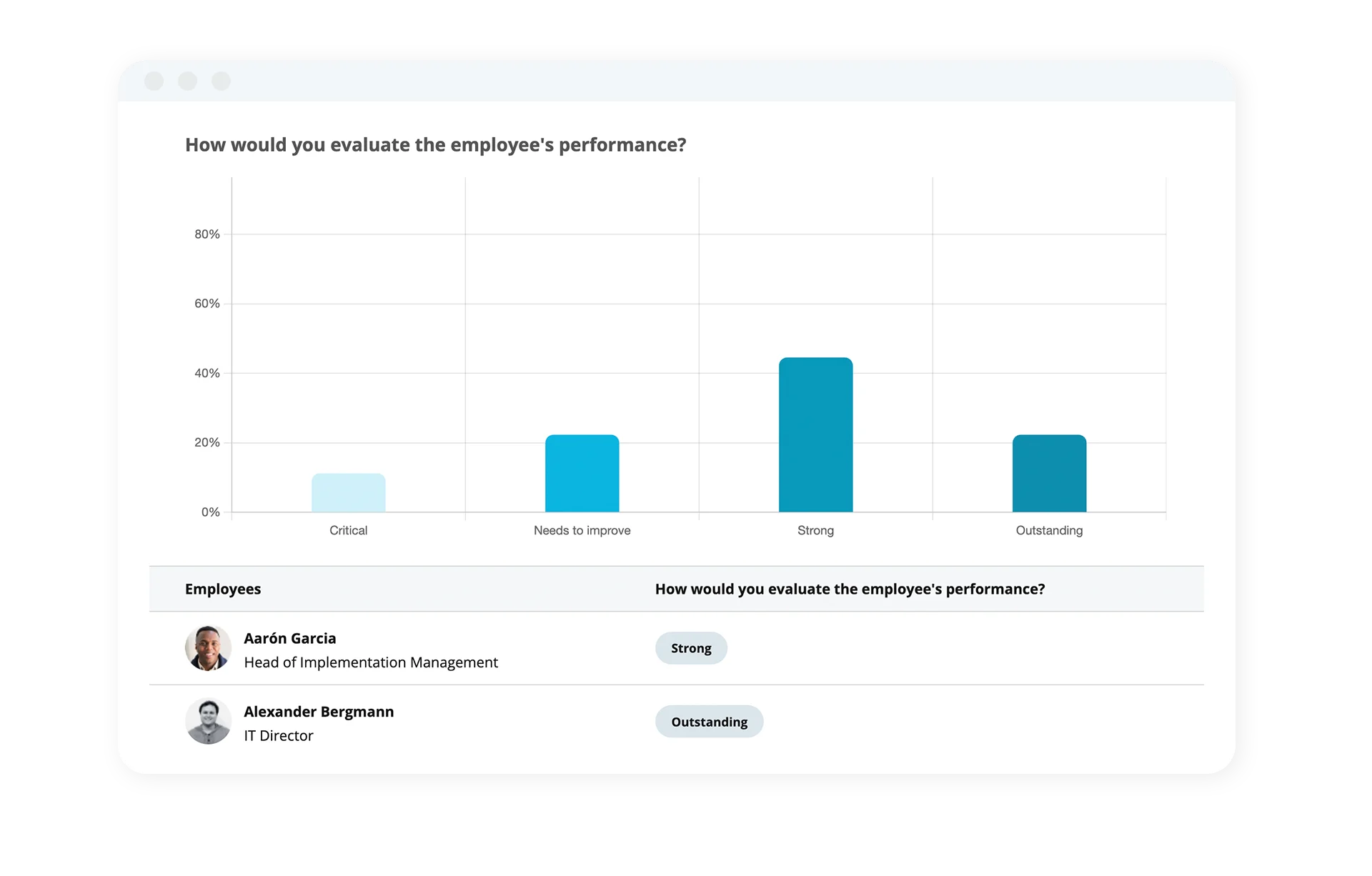
Some appraisals rely on data only (they address questions like, ‘Did you achieve your KPIs, what are the numbers?’). Others include the human contribution (answering questions like, ‘How do you work with others? Do you embody our company’s values).
The best ones balance both aspects. This is where an HR software like Personio can play a huge role, by helping balance all of those elements in an automated, customisable and engaging way for your employees.
4. Identify opportunities for learning and development

Nobody is perfect, and we all have room to improve. That’s why professional development is so important. As we said in our blog post about ‘How Can Strategic Professional Development Get the Best Out of Your Employees?‘, ‘84% of employees in best-performing organisations are receiving the training they need compared with 16% in the worst-performing companies’.
5. Openly discuss challenges affecting performance
How can underperforming employees improve if they don’t know what they’re doing wrong? Unless performance issues are addressed when they happen it’s likely that employees will forget they even happened: creating resentment when the issues are finally raised at appraisal time.
Without regular appraisals (informal ones are fine, too), it will be impossible for employees to improve over the course of a year. As our list of tips for conducting productive performance appraisals says below: be open, honest, and positive wherever possible.
6. Listen

This is such an important point that it is listed on its own with one single word. While employee performance appraisals are a chance for managers to tell employees where they performed well or badly, they should also be a chance for employees to discuss what they feel they did well and why.
Good managers provide feedback. Great managers listen to their staff first and then use this feedback opportunity to help align goals and values, correct misconceptions, or, better yet, celebrate wins and provide inspiration for the future.
7. Update goals for the next appraisal period
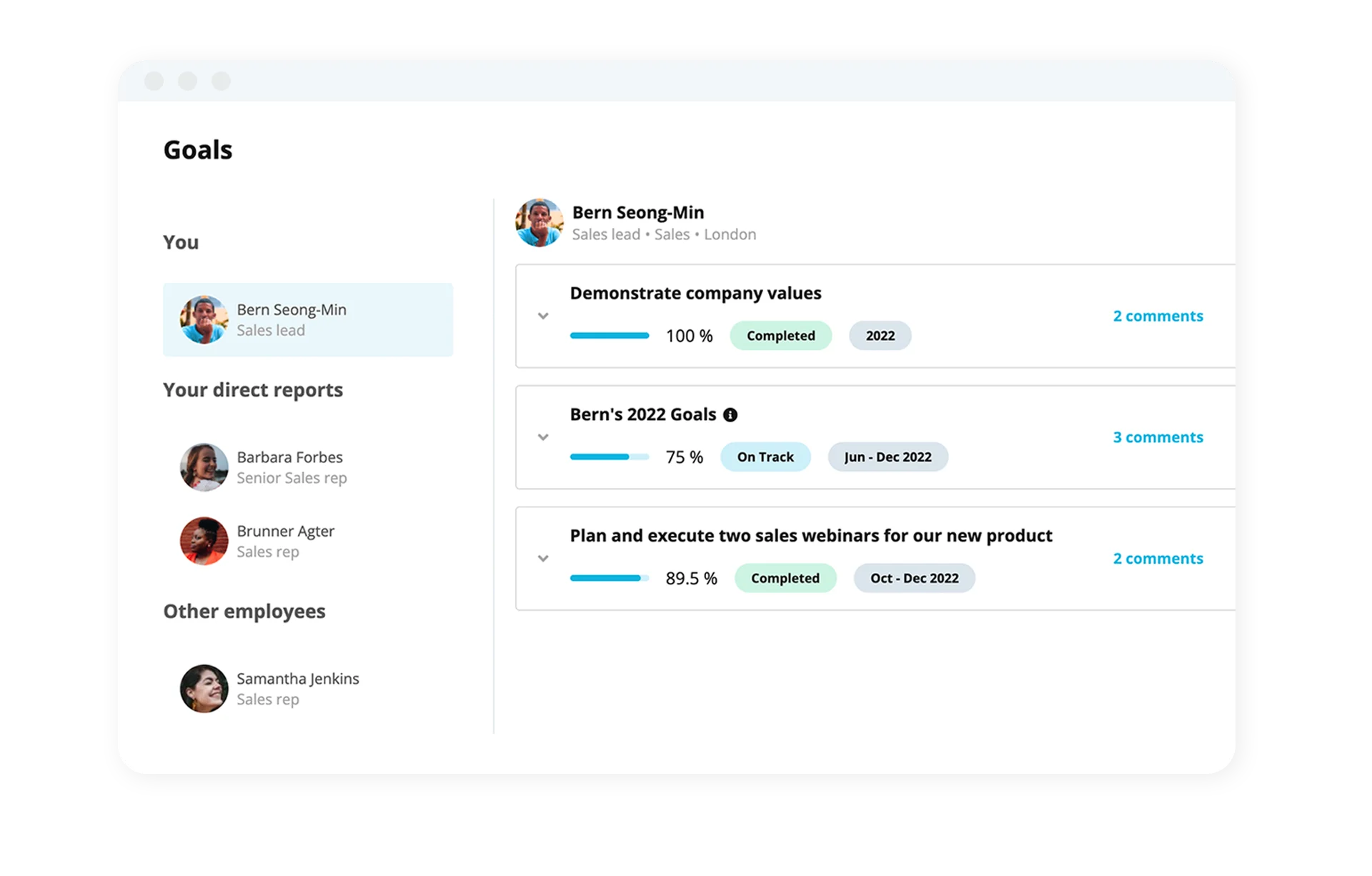
No matter what your performance appraisal cycle is, it’s always wise to leave employees at the end of a review cycle with a sense of hope and optimism.
Best practices for managing performance appraisals
When performance appraisals are part of a holistic approach to performance management, the benefits are clear:
Basis for salary and promotion: Performance reviews provide a sound basis for making informed decisions about salary increases and promotions.
Goal setting and progress: They allow you to set clear goals for visible progress, which, in turn, results in better performance.
Employee retention: Studies have shown that employees who are developed and supported in line with their abilities stay with their companies longer.
Regardless of the type of performance appraisal you want to run, it is important for HR to build out a programme and manage a process to help things run successfully. Here are some best practices to ensure effective performance appraisals:
Conduct appraisals more frequently
Best practice: Move beyond the annual review. Consider quarterly or semiannual appraisals to provide more timely feedback and keep employees engaged.
Benefit: Regular check-ins help address issues promptly and keep employees aligned with organisational goals.
Ensure clarity in evaluation criteria
Best practice: Clearly define the criteria and metrics used for evaluations. Make sure employees understand what is expected of them.
Benefit: Transparency in the appraisal process builds trust and helps employees focus on key performance areas.
Customise evaluation systems
Best practice: Tailor appraisal systems to fit the diverse roles and responsibilities within your organisation. Avoid a one-size-fits-all approach.
Benefit: Customised evaluations are more relevant and meaningful, leading to more accurate assessments.
Provide thorough and constructive feedback
Best practice: Ensure feedback is specific, actionable, and balanced. Highlight both strengths and areas for improvement.
Benefit: Constructive feedback fosters a growth mindset and helps employees understand how to improve.
Involve employees in goal setting
Best practice: Co-create goals with employees to ensure they are meaningful and achievable. Use the SMART criteria (Specific, Measurable, Achievable, Relevant, Time-bound).
Benefit: Collaborative goal setting increases employee buy-in and motivation to achieve targets.
Use a mix of appraisal methods
Best practice: Combine different appraisal methods such as top-down reviews, 360-degree feedback, and self-assessments to get a comprehensive view of performance.
Benefit: A mixed-method approach provides a well-rounded perspective and reduces biases.
Leverage technology
Best practice: Use HR software to streamline the appraisal process, track performance data, and facilitate regular feedback.
Benefit: Technology can enhance efficiency, accuracy, and consistency in performance management.
Focus on development and support
Best practice: Use appraisals as an opportunity to identify development needs and provide support through training and mentoring.
Benefit: Investing in employee development leads to higher engagement and retention.
Encourage open communication
Best practice: Foster a culture of open dialogue where employees feel comfortable sharing their thoughts and feedback.
Benefit: Open communication builds stronger relationships and helps address issues before they escalate.
Monitor and iterate the appraisal process
Best practice: Regularly review and refine the appraisal process based on feedback from employees and managers.
Benefit: Continuous improvement ensures the appraisal process remains relevant and effective.
By implementing these best practices, HR leaders can manage performance appraisals more effectively, ensuring they are a positive and productive experience for both employees and the organisation.
The 5 top challenges of managing performance appraisals
While performance appraisals can be a powerful tool for employee development and organisational growth, several challenges can hinder their effectiveness. Here are some common pitfalls and how to avoid them:
Spontaneous meetings or lack of time
Challenge: Scheduling appraisals without adequate notice or time can lead to rushed and unproductive discussions.
Solution: Schedule appraisals well in advance and allocate sufficient time for a thorough review. This ensures both parties are prepared and can engage in meaningful dialogue.
Poor preparation
Challenge: Managers who do not keep continuous records or fail to prepare adequately may provide vague or inaccurate feedback.
Solution: Maintain regular performance records and review them before the appraisal. This helps in providing specific, constructive feedback and shows employees that their performance is valued.
Providing unspecific statements or making accusations
Challenge: General or accusatory feedback can demotivate employees and lead to misunderstandings.
Solution: Offer clear, actionable feedback. Explain what went wrong, why it matters, and how the employee can improve. This approach fosters a growth mindset and encourages positive change.
Setting goals without employee involvement
Challenge: Goals imposed solely by management may lack employee buy-in and motivation.
Solution: Co-create goals with employees. This collaborative approach ensures that goals are meaningful and achievable, increasing engagement and commitment.
Using career opportunities or salaries to apply pressure
Challenge: Leveraging appraisals to pressure employees with promotions or salary changes can create a stressful environment.
Solution: Focus on holistic development. Highlight areas for improvement and recognise contributions without solely tying them to promotions or salary increments. This balanced approach promotes a healthier work culture.
Other factors to keep top of mind
Seasonal and cultural considerations
Challenge: The time of year and cultural differences can impact the effectiveness of appraisals.
Solution: Be mindful of seasonal variations and cultural contexts. For instance, employees in the Northern Hemisphere may be more upbeat in summer, while those in the Southern Hemisphere might be in a different mindset during winter. Tailor your approach accordingly to ensure relevance and sensitivity.
Financial year and tax implications
Challenge: Misalignment between the financial year and tax year can complicate budgeting and performance evaluations.
Solution: Understand the financial and tax year timelines in different regions. Align appraisals with these periods to ensure accurate budgeting and financial planning.
Incorporating 360-degree feedback
Challenge: Traditional top-down appraisals may not capture the full picture of an employee’s performance.
Solution: Implement 360-degree feedback where appropriate. This method allows for comprehensive feedback from peers, subordinates, and supervisors, providing a well-rounded view of performance. It also encourages self-awareness and continuous improvement.
By addressing these challenges and adopting a thoughtful, inclusive approach, HR professionals can enhance the effectiveness of performance appraisals, fostering a more engaged and productive workforce.
Run performance programmes with Personio
Performance with Personio, as part of our all-in-one HR software, means being able to run performance cycles across your entire organisation in minutes. Build your cycle, add the right people, include the right templates and you're off to a flying start.
Done in a completely automated way, Personio can help tie together all of your people processes by ensuring your appraisals happen and employees develop in kind. Learn more about our performance feature or chat with an expert today.
